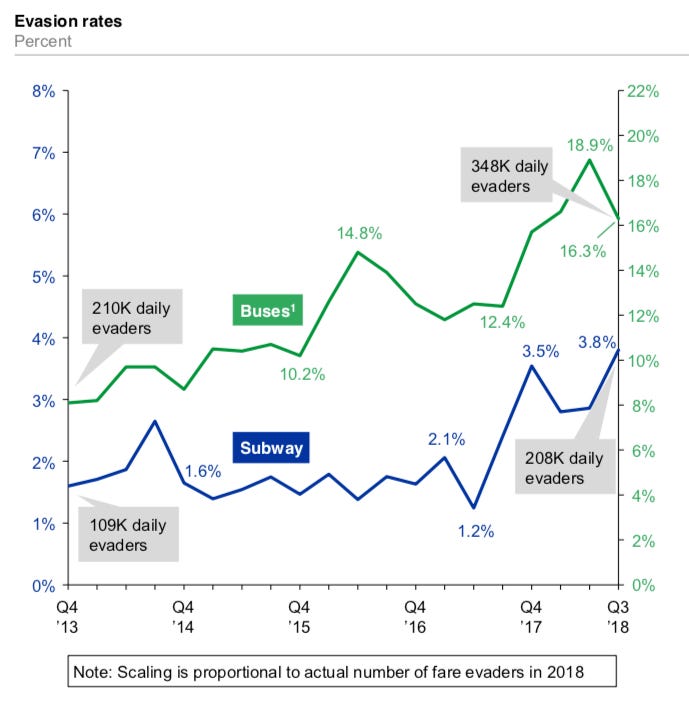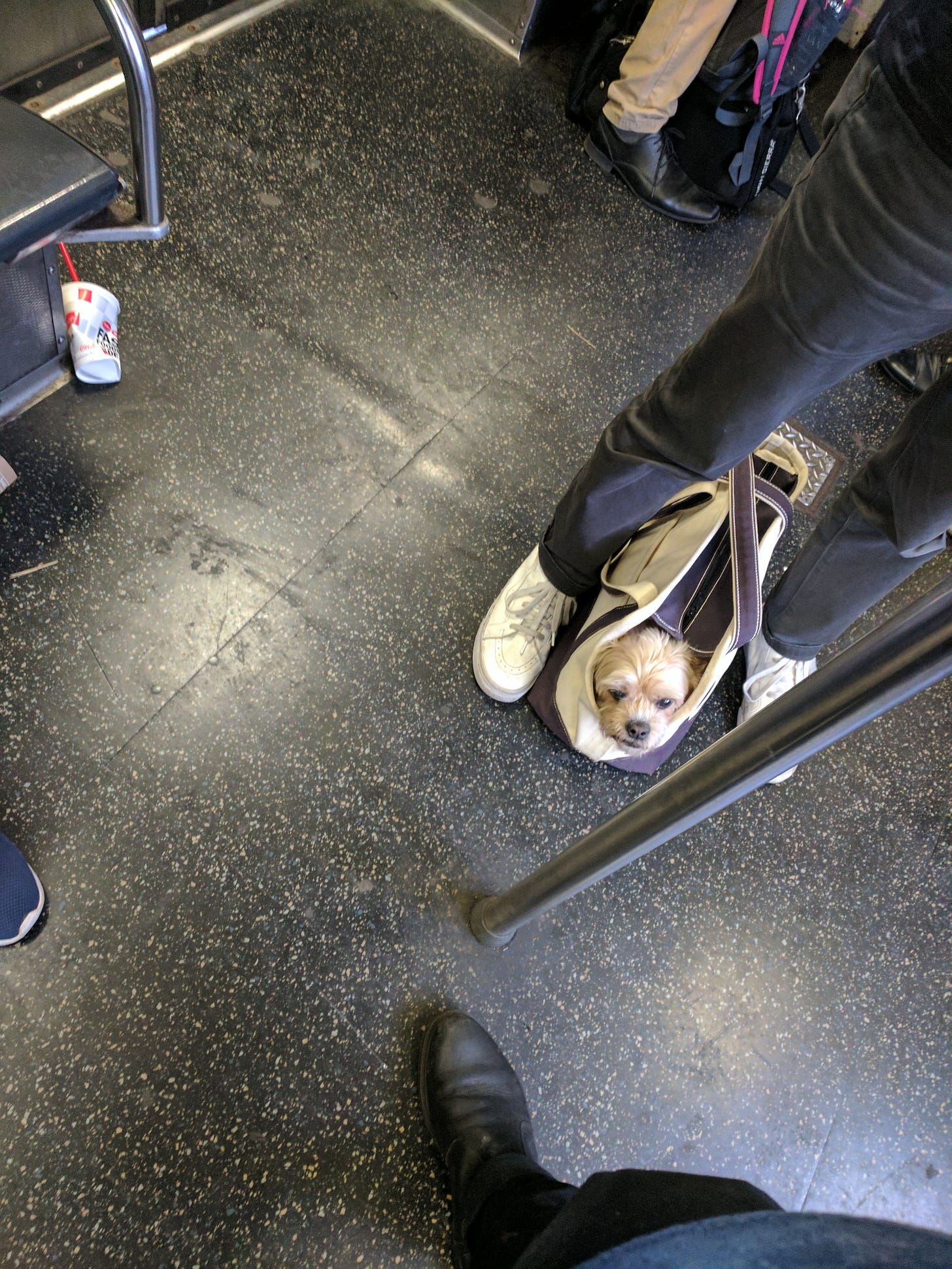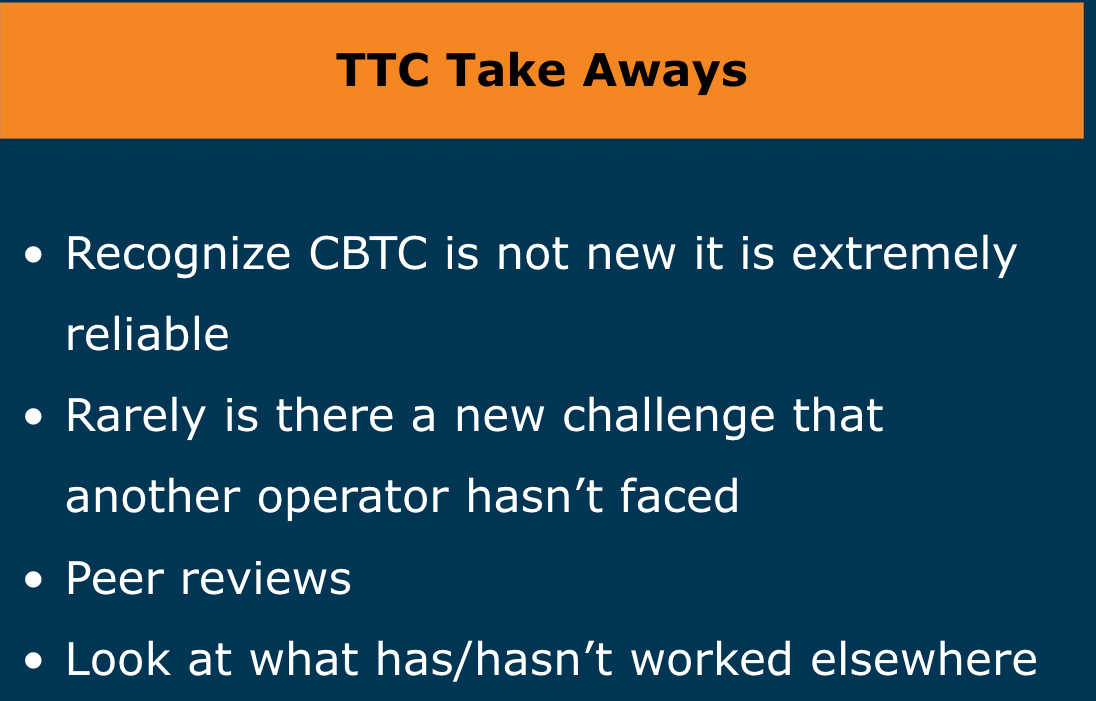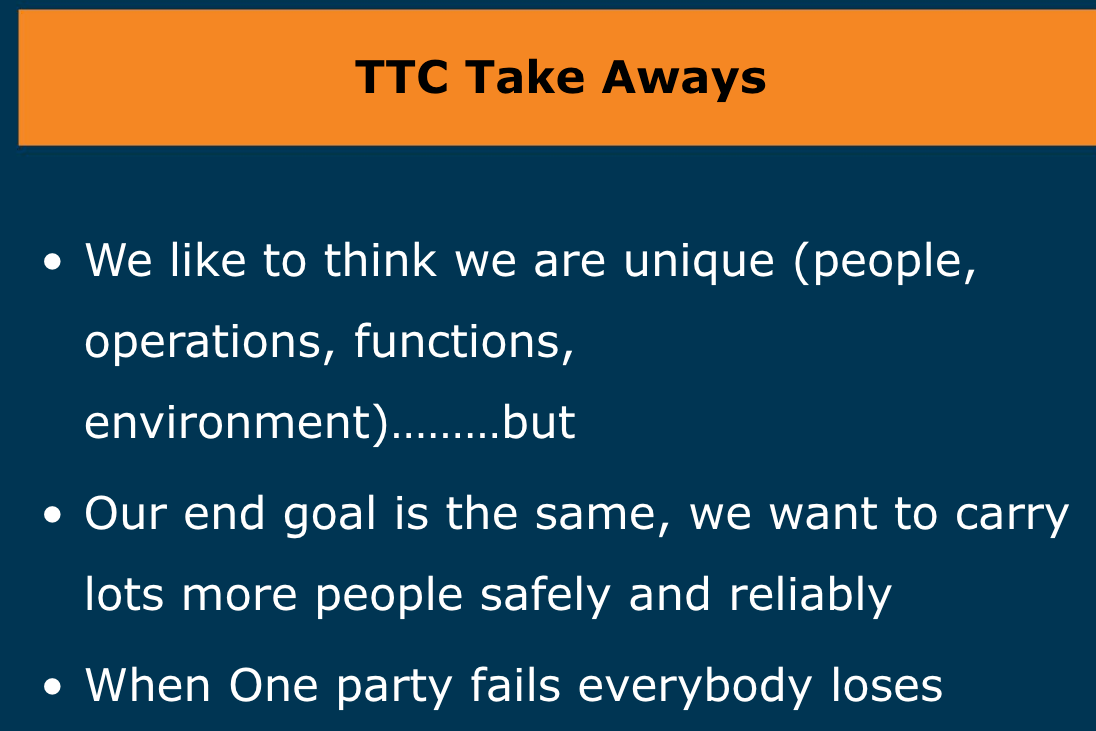What to make of fare evasion?
Thank you so much to everyone who became a paid subscriber! I’m excited to put together some fantastic special editions for you.
If you missed yesterday’s announcement, you can read it here. And my apologies to everyone who had trouble signing up yesterday. Substack, the newsletter platform, had some ill-timed technical difficulties. But everything is back to normal.
On Monday, the MTA Finance Committee discussed a long-awaited report on fare evasion. The “report” was really just an eight-slide PowerPoint woefully short on details and methodology breakdowns. When I asked the MTA if there is a more detailed, full report and when it will be released, a spokesman replied, “This is the report.”
According to the MTA, there are around 550,000 fare evaders on the subway and buses every single day. The MTA further estimates $215 million in “lost” revenue due to fare evasion this year, almost double the amount “lost” due to fare evasion in 2015. Here is the graph they used to illustrate the problem (chart nerds, avert your gaze):

I’ve put the term “lost” in quotes because I have absolutely no idea how NYCT came up with this estimate. The only clue they give in the presentation is this bullet point:
Evasion rates are calculated against paid ridership figures.
I don’t know what assumptions went into calculating those revenue figures or the daily evader projections. And those assumptions are incredibly important when extrapolating from observation-based samples. We know they counted people who didn’t swipe at various subway stations and bus routes, and that ultimately their computers churned out these estimates and figures. But, we don’t know, for example, if they’ve changed the method, location, or sample size of their observations over the five-year period, as they have with many other statistics. Everything in between is a total black box.
So, we’re left to evaluate these numbers as best we can. The MTA is saying that one out of every 25 subway riders are fare evaders, and about one out of every five bus riders doesn’t swipe. As Chase Tralka on Twitter pointed out, this averages out to one fare evader at every subway station every three minutes.
Without knowing more about the methodology, its possible there is some serious over-counting as a result of the MTA’s complicated fare structure, poorly-designed control areas, and service change policies. At its core, I worry this analysis conflates two distinct problems: people not paying for their ride versus the MTA not accurately counting riders.
For example, the presentation made the point that fare evasion through the subway service gate has increased four-fold since 2011, which accounts for the “vast majority” of the increase in fare evasion on subways. But it is quite the leap to assume everyone who enters the subway through the service gate is not paying their fair share. According to the most recent MetroCard report to the board (page 191), more than half of all trips are taken on unlimited MetroCards. Surely, many people entering through the service gate are doing so with unlimited cards in their possession simply because it’s easier or less crowded. Or perhaps they have bulky items and don’t feel like going through the cumbersome process of alerting the station attendant, swiping the card, backing up, and going through the service gate. Maybe there’s no station attendant at all.
And this is to say nothing of local buses, where NYCT estimates as much as one out of every five riders does not scan their card (evasion is lower on SBS, but still higher than the subway). Fare evasion is a much bigger problem on buses for sure—there is almost no enforcement and drivers are instructed not to intervene—but I do wonder, again, how many people simply don’t bother to swipe because they’re on a free transfer, or are waved through by a driver trying to speed things up.
In any event, this potential for over-counting and total lack of transparency on the report’s methodology would be bad enough if the presentation didn’t try to make the exact opposite point. In fact, NYCT argues, they were likely under-counting the problem because of such factors as “the inherent limits of human observers in a dynamic environment” and “the mere presence of field staff may limit evasion.”
These last notes concern me a great deal. If NYCT was truly interested in studying fare evasion, they would take basic measures to minimize these factors, such as dispatching plain-clothed employees. This, to me, raises a big red flag. Either they’re working backwards from a desired conclusion or not thinking through their methodology very carefully.
That’s not to say I think fare evasion is a non-problem. But this eight-page PowerPoint (OK yes the PDF is nine pages but no way am I counting the title slide) does not constitute transparency on the issue. Instead, I would characterize it more as an argument. And it’s not a particularly useful one, particularly given all the other challenges the MTA faces.
Even if everything the presentation says is accurate, it’s not even clear what should be done about it. As Byford has repeatedly stated, fare evasion is a fact of life on any transit system. At least as the subways are concerned, even these higher figures are not that far out of line with what the NYCT presentation dubs “peer metros” (which metros are they and what methodology do they use? Good question! The report doesn’t say).
But let’s grant the premise that fare evasion is a huge problem. Then what? Post cops at every turnstile? 89 percent of those arrested this year for fare evasion are black or Hispanic. In any formulation about how to move forward with fare evasion policing, this is a fact that simply cannot be brushed aside. What does equitable fare enforcement look like? How resource-intensive is it? Until there is a clear plan on this front, the MTA runs the risk of further encouraging discriminatory enforcement practices.
But the main reason this issue rings hollow to me has to do with why the report was even generated in the first place. The MTA board asked for it.
Indeed, the board’s disproportionate focus on fare evasion these last few months speaks volumes about their priorities. To me, it’s indicative of the MTA board not knowing its purpose. Does the MTA exist to be run as a self-sustaining entity? Or is it a public good funded primarily by tax revenue? And what is the board’s actual role in figuring that out?
Answering these questions would go a long way towards making the fare evasion question clearer. If the MTA ought to be self-sustaining, then it would have a rigorous cost-benefit calculus as to the optimal amount of fare evasion—which, by the way, is not zero, as that would require far too much enforcement—and how to best achieve it. On the other hand, if the MTA is delivering a public good, then very little energy should go to enforcing fares through draconian policing. Insofar as it would be interested in curbing fare evasion, the MTA would in this case be focused on design changes to the fare control areas. For example, turnstiles could be re-designed to prevent hopping—it almost seems to me like our turnstiles were specifically designed to facilitate hopping, unlike other fare control areas— and control doors closed again.
Further, the astronomical rate of fare evasion on buses would suggest it’s time to have a discussion about whether buses should have a fare at all. (There are a lot of other elements in favor of free buses, including social justice, income distribution, and traffic reduction/environmental arguments. That’s for another time.) Or, perhaps the MTA would simply need to adjust baseline assumptions for how much revenue is “lost” to fare evasion every year and work within those confines.
Whatever the case, the authority is not working from a clear institutional mindset about what it is and to whom it answers. That is partly a structural problem and partly a leadership problem, stemming both from a revolving door of chairmen over the last decade and a weak board with no overarching policy goals guiding its actions. The fare evasion debate epitomizes the MTA board’s shortcomings, where prolonged debates over fringe issues—$215 million is a mere 1.2 percent of the 2019 proposed budget; they regularly vote on larger, incredibly vague contracts with no discussion whatsoever—hog big chunks of debate.
Unfortunately, the MTA is currently the worst of both worlds, neither a sustainable entity nor a pure public good, and adopting the worst practices of each. This contradiction precludes a rational approach about a great many things. Fare evasion is just the latest example.
News You Probably Can't Use, But About Which You Can Certainly Brood
Really important hire for NYCT: Pete Tomlin, a CBTC expert, will be joining Transit in January. He has quite the CV, delivering CBTC projects in London, Toronto, and Hong Kong. According to the press release, his “first task will be to oversee the final adjustments to the CBTC system that just went live on the 7 line, to take charge of the current Queens Boulevard project and to commence planning for the next tranche of line conversions.” I really like what I’m seeing from this presentation he gave in 2015:
On Monday, the Bergen St interlocking on the F/G lines in Brooklyn melted down again. In short, there was a code failure involving the modern computerized solid-state interlocking. It’s an interlocking I’ve written about before, and worth at least keeping in mind as the cries for computerized everything continue to reverberate.
About halfway through the finance committee hearing, the chair, Larry Schwartz, casually mentioned “I don’t use the New York City bus” and asked for a brief explainer on how paying the fare on buses works.
PATH decided to announce two years of weekend closures for the WTC line one month in advance to do repairs for a storm that happened six years ago.
In response to the assertions that he is in part to blame for a rise in fare evasion because his office no longer prosecutes fare evaders, Manhattan DA Cy Vance issued a “fact sheet”. Basically, his office says criminalizing fare evasion is a dumb policy that doesn’t benefit anyone, including the MTA. It’s worth emphasizing that fare evasion is still illegal; violators receive fines or summonses rather than court appearances.
Byford spoke to the City Council for more than three hours on Tuesday. The most interesting bit was when Councilman Chaim Deutsch began his question by saying he recently started taking the subway and a lot of people on it seem very grumpy. He then proceeded to talk almost exclusively about bridge tolls, which Byford does not control.
A thinly-disguised MTA parody account on Twitter got one of its very stupid tweets to go viral because a bunch of people thought it was real somehow. Anyways, Twitter suspended the account at the MTA’s request.
Department of Low Bars: Mayor de Blasio promises to “do more” to clear bus lanes.
At a business conference Wednesday, Byford floated variable pricing for the subway once the new fare payment system is installed.
A few months ago, the MTA board discussed their policies for approving ads because some of the men on the board didn’t like a Momwasher ad that used the word “vagina” (the MTA, to be fair, is hardly the only entity concerned with running ads with the word “vagina”; Signal Problems, however, has no problem using the word “vagina”). Now, the MTA has rejected an ad for a bidet company called Tushy that featured ad copy such as “nothing says I love you like a clean butthole.” Tushy’s founder is also the former founder of Thinx, the period-underwear company that went through a similar and highly-publicized row with the MTA, but about the word “period” instead of buttholes, so I can only assume this is a very calculated effort to go for the the Streisand Effect.
Smoke a joint and save the subway, the Times says? Hell yeah, pass that right over he…oh, they mean use the tax revenue gained from marijuana legalization to fund the MTA. Sure, that’s good, too, I guess.
In seriousness, Times reporter Emma Fitzsimmons quotes a number of officials and policymakers who are taking this idea seriously. But, thinking beyond transportation here, legalizing marijuana would correct a generations-long injustice that disproportionately impacted minorities. I, personally, tend to agree with Councilmember Rafael Espinal, who thinks that tax revenue from legalization should go towards addressing the legacy of the drug war, such as by “fixing NYCHA, investing in bail programs for low-level offenders and funding economic development programs, especially for minority women and business owners in the marijuana industry.”More MTA FOIL fun from New York Times reporter Brian Rosenthal:
Considering we in New York are thinking about our transit landscape in big ways, I thought this proposal to create a single entity in charge of all mobility governance issues makes a lot of sense. At least, it makes a hell of a lot more sense than having the bus stops owned by a different agency than the buses.
The Times is collecting stories, photos, etc. on whether the subways are improving.
Andy Byford got eight write-in votes for Governor. Joe Lhota got one.
In Which I Make An Educated Guess About When Things Will Get Better
This week's estimate: June 2022
Change log (the links are where I explain the change):
May 25, 2018: June 2022
March 30, 2018: 2030
March 16, 2018: 2024
February 2, 2018: 2021
January 20, 2018: 2020
Your Upcoming Service Advisories, Provided by Lance from Subway Weekender
Note: the service advisories reflect the most disruptive changes. Be sure to check the maps or the MTA website for a full list of service changes.
Weekend:
7 – No service between Willets Point and Main St
E – No service between Briarwood and Jamaica Center
F – No service between Church Av and Coney Island
G – No service between Nassau Av and Court Square
J – No service between Hewes St and Jamaica Center
M – No weekend service
N – No service between Queensboro Plaza and Ditmars Blvd
S (Franklin Ave) – No daytime service
Late Nights:
2 – No service between Chambers St and Atlantic Av
3 – No overnight service
A – multiple diversions
No service between Jay St and Utica Av
Brooklyn-bound service runs via F line between W 4 Street and Jay St
D – No service between 34 St-Herald Sq and 9 Avenue
E – multiple diversions
No service between Briarwood and Jamaica Center
Downtown service runs via F line between Roosevelt Av and W 4 Street
F – multiple diversions
All service is local-only in Queens
Jamaica-bound service runs via E line between Rockefeller Center and Roosevelt Av
G – No service between Bedford-Nostrand Avs and Court Square
N – No service between Atlantic Av and 59 St/4 Av
R – No overnight service
Meanwhile, in the Rest of the World
Only one link this week: Madrid is allowing only zero-emissions vehicles to move freely in the city center.
Speaking of free transit, Luxembourg is making all public transportation free.
Subway Eating Story
If you have a subway eating story (that doesn’t involve someone making a mess because we don’t want to encourage that type of behavior) send it along to signalproblems@substack.com.
This week’s horrifying story comes from Julianne Simson:
Tonight I'm sharing a story that will make you want to wash your hands immediately after your commute tomorrow...
My boyfriend and I were on the E heading to the G from LaGuardia. It was pretty recent after moving to the city a few years ago, so we didn't know to look for warning signs like "empty cars" yet. We sat down, and I was immediately yelled at by a woman for wearing ripped jeans for "fashion." Simultaneously, she was eating a mostly melted Hershey bar. Just imagine: an angry fashion rant from a toothless woman, who, after every few words, would lick the wrapper one last time. Then, the real kicker (or licker): she paused to stick a finger in her mouth, one at a time, to suck off the last few drops of chocolate... then wipe her hands down the pole in front of her. Pop, pop, pop, pop, squeeeeeeak. Repeat.
I've learned my lesson and haven't worn ripped jeans ever since.
The lesson I learned is that I will never be able to look at a Hershey bar the same way.
Dog in a Bag
MTA Rules of Conduct Section 1050.9 Subsection (h) Paragraph 2: no person may bring any animal on or into any conveyance or facility unless enclosed in a container and carried in a manner which would not annoy other passengers.
Have a dog in a bag photo? Reading this on the subway and see a dog in a bag? Take a picture and send it to signalproblems@substack.com.

Photo credit: Paul Ross
This has been another edition of Signal Problems, a weekly newsletter helping you figure out what is going on with the subway, made every week by Aaron Gordon, freelance transportation reporter. Read on the web or view the archives at signalproblems.nyc.
If you’re enjoying this newsletter, please share it with others. It’s the best way you can say thanks.
As always, send any feedback, subway questions, or Dog in a Bag photos to signalproblems@substack.com. I’d love to hear from you. As someone on a stalled Q train once told me, we’re all in this together.



